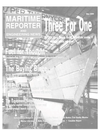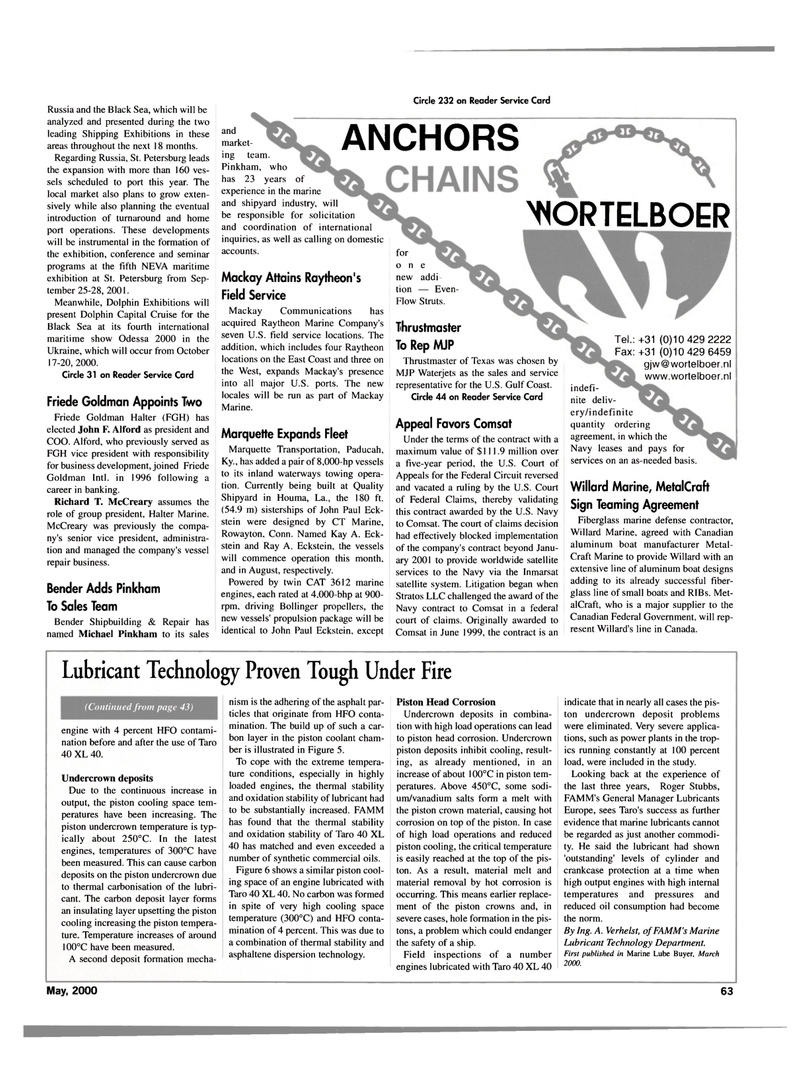
Page 65: of Maritime Reporter Magazine (May 2000)
Read this page in Pdf, Flash or Html5 edition of May 2000 Maritime Reporter Magazine
Russia and the Black Sea, which will be analyzed and presented during the two leading Shipping Exhibitions in these areas throughout the next 18 months.
Regarding Russia, St. Petersburg leads the expansion with more than 160 ves- sels scheduled to port this year. The local market also plans to grow exten- sively while also planning the eventual introduction of turnaround and home port operations. These developments will be instrumental in the formation of the exhibition, conference and seminar programs at the fifth NEVA maritime exhibition at St. Petersburg from Sep- tember 25-28, 2001.
Meanwhile, Dolphin Exhibitions will present Dolphin Capital Cruise for the
Black Sea at its fourth international maritime show Odessa 2000 in the
Ukraine, which will occur from October 17-20, 2000.
Circle 31 on Reader Service Card
Friede Goldman Appoints Two
Friede Goldman Halter (FGH) has elected John F. Alford as president and
COO. Alford, who previously served as
FGH vice president with responsibility for business development, joined Friede
Goldman Intl. in 1996 following a career in banking.
Richard T. McCreary assumes the role of group president, Halter Marine.
McCreary was previously the compa- ny's senior vice president, administra- tion and managed the company's vessel repair business.
Bender Adds Pinkham
To Sales Team
Bender Shipbuilding & Repair has named Michael Pinkham to its sales
Circle 232 on Reader Service Card and market- ing team.
Pinkham, who has 23 years of experience in the marine and shipyard industry, will be responsible for solicitation and coordination of international inquiries, as well as calling on domestic accounts.
Mackay Attains Raytheon's
Field Service
Mackay Communications has acquired Raytheon Marine Company's seven U.S. field service locations. The addition, which includes four Raytheon locations on the East Coast and three on the West, expands Mackay's presence into all major U.S. ports. The new locales will be run as part of Mackay
Marine.
Marquette Expands Fleet
Marquette Transportation, Paducah,
Ky., has added a pair of 8,000-hp vessels to its inland waterways towing opera- tion. Currently being built at Quality
Shipyard in Houma, La., the 180 ft. (54.9 m) sisterships of John Paul Eck- stein were designed by CT Marine,
Rowayton, Conn. Named Kay A. Eck- stein and Ray A. Eckstein, the vessels will commence operation this month, and in August, respectively.
Powered by twin CAT 3612 marine engines, each rated at 4,000-bhp at 900- rpm, driving Bollinger propellers, the new vessels' propulsion package will be identical to John Paul Eckstein, except
ANCHORS
WDRTELBOER for one new addi tion — Even-
Flow Struts.
Thrustmaster
To Rep MJP
Thrustmaster of Texas was chosen by
MJP Waterjets as the sales and service representative for the U.S. Gulf Coast.
Circle 44 on Reader Service Card
Appeal Favors Comsat
Under the terms of the contract with a maximum value of $111.9 million over a five-year period, the U.S. Court of
Appeals for the Federal Circuit reversed and vacated a ruling by the U.S. Court of Federal Claims, thereby validating this contract awarded by the U.S. Navy to Comsat. The court of claims decision had effectively blocked implementation of the company's contract beyond Janu- ary 2001 to provide worldwide satellite services to the Navy via the Inmarsat satellite system. Litigation began when
Stratos LLC challenged the award of the
Navy contract to Comsat in a federal court of claims. Originally awarded to
Comsat in June 1999, the contract is an
Tel.: +31 (0)10 429 2222
Fax: +31 (0)10 429 6459 [email protected] www.wortelboer.nl indefi- nite deliv- ery/indefinite quantity ordering agreement, in which the
Navy leases and pays for services on an as-needed basis.
Willard Marine, MetalCraft
Sign Teaming Agreement
Fiberglass marine defense contractor,
Willard Marine, agreed with Canadian aluminum boat manufacturer Metal-
Craft Marine to provide Willard with an extensive line of aluminum boat designs adding to its already successful fiber- glass line of small boats and RIBs. Met- alCraft, who is a major supplier to the
Canadian Federal Government, will rep- resent Willard's line in Canada.
Lubricant Technology Proven Tough Under Fire (Continued from page 43) engine with 4 percent HFO contami- nation before and after the use of Taro 40 XL 40.
Undercrown deposits
Due to the continuous increase in output, the piston cooling space tem- peratures have been increasing. The piston undercrown temperature is typ- ically about 250°C. In the latest engines, temperatures of 300°C have been measured. This can cause carbon deposits on the piston undercrown due to thermal carbonisation of the lubri- cant. The carbon deposit layer forms an insulating layer upsetting the piston cooling increasing the piston tempera- ture. Temperature increases of around 100°C have been measured.
A second deposit formation mecha- nism is the adhering of the asphalt par- ticles that originate from HFO conta- mination. The build up of such a car- bon layer in the piston coolant cham- ber is illustrated in Figure 5.
To cope with the extreme tempera- ture conditions, especially in highly loaded engines, the thermal stability and oxidation stability of lubricant had to be substantially increased. FAMM has found that the thermal stability and oxidation stability of Taro 40 XL 40 has matched and even exceeded a number of synthetic commercial oils.
Figure 6 shows a similar piston cool- ing space of an engine lubricated with
Taro 40 XL 40. No carbon was formed in spite of very high cooling space temperature (300°C) and HFO conta- mination of 4 percent. This was due to a combination of thermal stability and asphaltene dispersion technology.
Piston Head Corrosion
Undercrown deposits in combina- tion with high load operations can lead to piston head corrosion. Undercrown piston deposits inhibit cooling, result- ing, as already mentioned, in an increase of about 100°C in piston tem- peratures. Above 450°C, some sodi- um/vanadium salts form a melt with the piston crown material, causing hot corrosion on top of the piston. In case of high load operations and reduced piston cooling, the critical temperature is easily reached at the top of the pis- ton. As a result, material melt and material removal by hot corrosion is occurring. This means earlier replace- ment of the piston crowns and, in severe cases, hole formation in the pis- tons, a problem which could endanger the safety of a ship.
Field inspections of a number engines lubricated with Taro 40 XL 40 indicate that in nearly all cases the pis- ton undercrown deposit problems were eliminated. Very severe applica- tions, such as power plants in the trop- ics running constantly at 100 percent load, were included in the study.
Looking back at the experience of the last three years, Roger Stubbs,
FAMM's General Manager Lubricants
Europe, sees Taro's success as further evidence that marine lubricants cannot be regarded as just another commodi- ty. He said the lubricant had shown 'outstanding' levels of cylinder and crankcase protection at a time when high output engines with high internal temperatures and pressures and reduced oil consumption had become the norm.
By Ing. A. Verhelst, of FAMM's Marine
Lubricant Technology Department.
First published in Marine Lube Buyer, March 2000.
May, 2000 63

 64
64

 3rd Cover
3rd Cover
